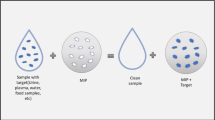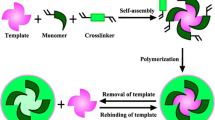Abstract
Over the past decade, several studies have reported trace levels of endocrine disrupting compounds, pharmaceuticals, and personal care products in surface waters, drinking water, and wastewater effluents. There has also been an increased concern about the ecological and human health impact of these contaminants, and their removal from water and wastewater has become a priority. Traditional treatment processes are limited in their ability to remove emerging contaminants from water, and there is a need for new technologies that are effective and feasible. This paper presents a review on recent research results on molecularly imprinted (MIP) and non-imprinted (NIP) polymers and evaluates their potential as a treatment method for the removal of emerging contaminants from water and wastewater. It also discusses the relative benefits and limitations of using MIP or NIP for water and wastewater treatment. MIP, and in particular NIP, offer promising applications for wastewater treatment, but their toxicity and possible health effects should be carefully studied before they are considered for drinking water treatment. More research is also required to determine how best to incorporate MIP and NIP in treatment plants.
Similar content being viewed by others
References
Adams CD, Randtke SJ (1992) Ozonation by products of atrazine in synthetic and natural waters. Environ Sci Technol 26:2218–27
Alexander C, Andersson HS, Andersson LI, Ansell RJ, Kirsch N, Nicholls IA, O’Mahony J, Whitcombe MJ (2006) Molecular imprinting science and technology: a survey of the literature for the years up to and including 2003. J Mol Recognit 19:106–80
Ashby J, Houthoff E, Kennedy SJ, Stevens J, Bars R, Jekat FW, Campbell P, Van Miller J, Carpanini FM, Randall GLP (2011) The challenge posed by endocrine-disrupting chemicals. Environ Heal Perspect 105(2):164–69
Ashraf S, Cluley A, Mercado C, Mueller A (2011) Imprinted polymers for the removal of heavy metal ions from water. Water Sci Technol 64(6):1325–32
Bögi C, Schwaiger J, Ferling H, Mallow U, Steineck C, Sinowatz F, Kalbfus W, Negele RD, Lutz I, Kloas W (2003) Endocrine effects of environmental pollution on Xenopus laevis and Rana temporaria. Environ Res 93:195–201
Braeken L, Van der Bruggen B (2009) Feasibility of nanofiltration for the removal of endocrine disrupting compounds. Desalination 240:127–31
Clara M, Kreuzinger N, Strenn B, Gans O, Kroiss H (2005) The solids retention time—a suitable design parameter to evaluate the capacity of wastewater treatment plants to remove micropollutants. Water Res 39:97–106
Deng S, Shuai D, Yu Q, Huang J, Yu G (2009) Selective sorption of perfluorooctane sulfonate on molecularly imprinted polymer adsorbents. Front Environ Sci Eng China 3:171–7
Fernández-Alvarez P, Le Noir M, Guieysse B (2009) Removal and destruction of endocrine disrupting contaminants by adsorption with molecularly imprinted polymers followed by simultaneous extraction and phototreatment. J Hazard Mater 163:1107–12
Fuerhacker M, Dürauer A, Jungbauer A (2001) Adsorption isotherms of 17β-estradiol on granular activated carbon (GAC). Chemosphere 44:1573–9
Gillesby BE, Zacharewski TR (1998) Exoestrogens: mechanisms of action and strategies for identification and assessment. Environ Toxicol Chem 17:3–14
Guo YC, Krasner SW (2009) Occurrence of primidone, carbamazepine, caffeine, and precursors for N-nitrosodimethylamine in drinking water sources impacted by wastewater. J Am Water Resour Assoc 45:58–67
Guo W, Hu W, Pan J, Zhou H, Guan W, Wang X, Dai J, Xu L (2011) Selective adsorption and separation of BPA from aqueous solution using novel molecularly imprinted polymers based on kaolinite/Fe3O4 composites. Chem Eng J 171:603–11
Hajizadeh S, Kirsebom H, Galaev IY, Mattiasson B (2010) Evaluation of selective composite cryogel for bromate removal from drinking water. J Sep Sci 33:1752–9
Hassanzadeh-Khayyat M, Lai EPC, Kollu K, Ormeci B (2011) Degradation of diclofenac in molecularly imprinted polymer submicron particles by UV light irradiation and HCl acid treatment. J Water Resource Protect 3(9):643–54
Helfman GS (2007) Fish conservation: a guide to understanding and restoring global aquatic biodiversity and fishery resources. Island Press, Washington
Karlsson JG, Andersson LI, Nicholls IA (2001) Probing the molecular basis for ligand-selective recognition in molecularly imprinted polymers selective for the local anaesthetic bupivacaine. Anal Chim Acta 435(1):57–64
Krupadam RJ, Khan MS, Wate SR (2010) Removal of probable human carcinogenic polycyclic aromatic hydrocarbons from contaminated water using molecularly imprinted polymer. Water Res 44:681–8
Lai EPC, Hassanzadeh-Khayyat M, Do G (2011) Degradation kinetics of pharmaceuticals in molecularly imprinted polymer particles by acid and hydrogen peroxide treatments. Clin Biochem 44:S8
Le Noir M, Lepeuple AS, Guieysse B, Mattiasson B (2007a) Selective removal of 17beta-estradiol at trace concentration using a molecularly imprinted polymer. Water Res 41:2825–31
Le Noir M, Plieva F, Hey T, Guieysse B, Mattiasson B (2007b) Macroporous molecularly imprinted polymer/cryogel composite systems for the removal of endocrine disrupting trace contaminants. J Chrom 1154:158–64
Li Y, Li X, Li Y, Qi J, Bian J, Yuan Y (2009) Selective removal of 2,4-dichlorophenol from contaminated water using non-covalent imprinted microspheres. Environ Pollut (Barking, Essex: 1987) 157:1879–85
Lin Y, Shi Y, Jiang M, Jin Y, Peng Y, Lu B, Dai K (2008) Removal of phenolic estrogen pollutants from different sources of water using molecularly imprinted polymeric microspheres. Environ Pollut (Barking, Essex: 1987) 153:483–91, http://www.ncbi.nlm.nih.gov/pubmed/17870222
Luo X, Zhan Y, Huang Y, Yang L, Tu X, Luo S (2011) Removal of water-soluble acid dyes from water environment using a novel magnetic molecularly imprinted polymer. J Hazard Mater 187:274–82
Masqué N (2001) Molecularly imprinted polymers: new tailor-made materials for selective solid-phase extraction. Trends Anal Chem 20:477–86
Meng Z, Chen W, Mulchandani A (2005) Removal of estrogenic pollutants from contaminated water using molecularly imprinted polymers. Environ Sci Technol 39:8958–62
Meng Z, Zhang Q, Xue M, Wang D, Wang A (2012) Removal of 2,4,6-trinitrotoluene from “pink water” using molecularly-imprinted absorbent. Propellants, Explosives, Pyrotechnics 37:100–6
Murray A (2009) evaluation of molecularly imprinted and non-imprinted nanoparticles for removal of endocrine disrupting compounds from surface water and wastewater. Master’s thesis, Department of Civil and Environmental Engineering, Carleton University
Murray A, Ormeci B, Lai EPC (2011) Removal of 17 beta-estradiol (E2) and its chlorination by-products from water and wastewater using non-imprinted polymer (NIP) particles. Water Sci Technol 64:1291–7
Pichon V, Chapuis-Hugon F (2008) Role of molecularly imprinted polymers for selective determination of environmental pollutants—a review. Anal Chim Acta 622:48–61
Randhawa M, Gartner I, Becker C, Student J, Chai M, Mueller A (2007) Imprinted polymers for water purification. J Appl Polym Sci 106:3321–6
Segner H, Caroll K, Fenske M, Janssen CR, Maack G, Pascoe D, Schäfers C, Vandenbergh GF, Watts M, Wenzel A (2003) Identification of endocrine-disrupting effects in aquatic vertebrates and invertebrates: report from the European IDEA project 54:302–14
Shen X, Zhu L, Li J, Tang H (2007) Synthesis of molecularly imprinted polymer coated photocatalysts with high selectivity. Chem Commun 11:1163–1165
Snyder S, Adham S, Redding AM, Cannon FS, DeCarolis J, Oppenheimer J, Wert EC, Yoon Y (2007) Role of membranes and activated carbon in the removal of endocrine disruptors and pharmaceuticals. Desalination 202:156–81
Spivak DA (2005) Selectivity in molecularly imprinted matrices. In: Yan M, Ramström O (eds) Molecularly imprinted materials—science and technology. Marcel Dekker, New York, pp 395–418
Vieno N, Tuhkanen T, Kronberg L (2006) Removal of pharmaceuticals in drinking water treatment: effect of chemical coagulation. Environ Technol 27:183–92
Xia X, Lai EP, Ormeci B (2012) Ultrasonication-assisted synthesis of molecularly imprinted polymer-encapsulated magnetic nanoparticles for rapid and selective removal of 17B-estradiol from aqueous environment. Polymer Engineering and Science, doi: 10.1002/pen.23126
Xie Y, Li H, Wang L, Liu Q, Shi Y, Zheng H, Zhang M, Wu Y, Lu B (2011) Molecularly imprinted polymer microspheres enhanced biodegradation of bisphenol A by acclimated activated sludge. Water Res 45:1189–98
Yang M, Park MS, Lee HS (2006) Endocrine disrupting chemicals: human exposure and health risks. J Environ Sci Health C Environ Carcinog Ecotoxicol Rev 24:183–224
Yu Q, Deng S, Yu G (2008) Selective removal of perfluorooctane sulfonate from aqueous solution using chitosan-based molecularly imprinted polymer adsorbents. Water Res 42:3089–97
Zhang Z, Hu J (2010) Effect of environmental factors on estrogenic compounds adsorption by MIP. Water Air Soil Pollut 210:255–64
Zhang Q, Deng S, Yu G, Huang J (2011) Removal of perfluorooctane sulfonate from aqueous solution by crosslinked chitosan beads: sorption kinetics and uptake mechanism. Bioresour Technol 102:2265–71
Zhongbo Z, Hu J (2008) Selective removal of estrogenic compounds by molecular imprinted polymer (MIP). Water Res 42:4101–8
Author information
Authors and Affiliations
Corresponding author
Additional information
Responsible editor: Hongwen Sun
Rights and permissions
About this article
Cite this article
Murray, A., Örmeci, B. Application of molecularly imprinted and non-imprinted polymers for removal of emerging contaminants in water and wastewater treatment: a review. Environ Sci Pollut Res 19, 3820–3830 (2012). https://doi.org/10.1007/s11356-012-1119-2
Received:
Accepted:
Published:
Issue Date:
DOI: https://doi.org/10.1007/s11356-012-1119-2




